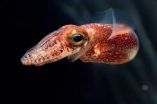(Press-News.org) MADISON, Wis. – The small but charismatic Hawaiian bobtail squid is known for its predator-fooling light organ.
To survive, the nocturnal cephalopod depends on a symbiotic association with a luminescent bacterium that gives it the ability to mimic moonlight on the surface of the ocean and, in the fashion of a Klingon cloaking device, deceive barracuda and other fish that would happily make a meal of the small creature.
The relationship between the squid and the bacterium Vibrio fischeri is well chronicled, but writing in the current issue of the journal Proceedings of the Royal Society B, a group led by University of Wisconsin-Madison microbiologists Margaret McFall-Ngai, Edward Ruby and their colleagues adds a new wrinkle to the story.
"The squid has seen an opportunity to recruit an organism to make light," explains McFall-Ngai, a UW-Madison professor of medical microbiology in the School of Medicine and Public Health. "But to do that you have to tame it. You have to train it to do what you want it to do."
In the case of the bobtail squid, it seems that the blood pigment hemocyanin plays a dual role in helping the squid recruit and sustain the bacterium it uses to avoid predation.
Like its human analog hemoglobin, hemocyanin is primarily responsible for transporting oxygen from the squid respiratory system to the rest of the body. But the hemocyanin protein also appears to be deployed in a way to help the squid recruit its population of Vibrio fischeri, which the squid flushes and replenishes on a daily cycle to enable its nocturnal defenses.
"In the early events of symbiosis, hemocyanin appears to have antimicrobial activity," says Ruby, also a UW-Madison professor of medical microbiology and a co-author of the new report. "We think it is part of the mechanism by which Vibrio fischeri become specific."
In essence, the squid is using the antimicrobial properties of hemocyanin to weed out competing bacteria so that only the glowing Vibrio fischeri can colonize the surfaces of the crypts that compose the squid's defensive light organ.
How Vibrio fischeri copes with the antimicrobial properties of the squid's blood pigment is an unanswered question, but agents with selective antimicrobial activity are not unknown: "People tend to assume that whenever they encounter an antimicrobial, it is meant to kill everything," Ruby notes. "Here, we know some bacteria are being courted."
The second role played by the hemocyanin protein in helping to establish symbiosis is more in keeping with its traditional function of ferrying oxygen. The oxygen-transporting properties of hemocyanin are exploited by the squid as the symbiotic population of Vibrio fischeri requires lots of oxygen to fuel the chemical reaction that causes the microbe to light up in the dark. The animal seems able to direct its symbionts to modulate the acidity of the crypts where they take up residence, creating oxygen rich niches at night while suppressing the flow of oxygen during the day when the squid has no need of its companions' glow.
"At night the squid is creating an environment that is more acidic, where oxygen is more easily dumped," says Ruby.
"Oxygen is really pivotal," adds McFall-Ngai. "There is a lot of energy that goes into making light."
The new findings, according to the Wisconsin biologists, help reveal some of the hidden rules of symbiosis, processes that are also likely occurring in higher animals, including humans, who also depend on microbes to perform critical services.
"There is a dynamic interplay in symbiosis," says McFall-Ngai, who designed and performed the study with UW-Madison post-doctoral fellow Natacha Kremer, the lead author of the Proceedings of the Royal Society B report. "In humans, there is an ecological succession in microbiota. What we are looking for in our model are the general themes."
INFORMATION:
—Terry Devitt, 608-262-8282, trdevitt@wisc.edu
The study described in this release was supported by an award from the Marie Curie Actions, and grants from the National Science Foundation, and the National Institutes of Health, NIGMS T32 GM008505, AI 50661 and OD 011024.
The color of blood: Pigment helps stage symbiosis in squid
2014-05-15
ELSE PRESS RELEASES FROM THIS DATE:
Synthetic biology still in uncharted waters of public opinion
2014-05-15
The Synthetic Biology Project at the Woodrow Wilson International Center for Scholars is releasing the results of a new set of focus groups, which find continued low awareness of synthetic biology among the general public.
The focus groups also sought opinions on the emerging field of neural engineering.
The focus group results support the findings of a quantitative national poll conducted by Hart Research Associates in January 2013, which found just 23 percent of respondents reported they had heard a lot (6 percent) or some (17 percent) about synthetic biology.
The ...
Added benefit of the fixed combination of dapagliflozin and metformin is not proven
2014-05-15
The fixed combination of the drugs dapagliflozin and metformin (trade name: Xigduo) has been approved since January 2014 for adults with type 2 diabetes in whom diet and exercise do not provide adequate glycaemic control. In an early benefit assessment pursuant to the Act on the Reform of the Market for Medicinal Products (AMNOG), the German Institute for Quality and Efficiency in Health Care (IQWiG) now examined whether this new drug combination offers an added benefit over the appropriate comparator therapy. No such added benefit can be derived from the dossier, however, ...
Mothers' symptoms of depression predict how they respond to child behavior
2014-05-15
Depressive symptoms seem to focus mothers' responses on minimizing their own distress, which may come at the expense of focusing on the impact their responses have on their children, according to research published in Psychological Science, a journal of the Association for Psychological Science.
Depressive symptoms are common among mothers, and these symptoms are linked with worse developmental outcomes for children. The new study, which followed 319 mothers and their children over a two-year period, helps to explain why parenting competence seems to deteriorate as parents' ...
Justifying wartime atrocities alters memories
2014-05-15
PRINCETON, N.J.—Stories about wartime atrocities and torture methods, like waterboarding and beatings, often include justifications – despite whether the rationale is legitimate.
Now, a study by Princeton University's Woodrow Wilson School shows how those justifications actually creep into people's memories of war, excusing the actions of their side. The researchers report in Psychological Science shows how Americans' motivation to remember information that absolves American soldiers of atrocities alters their memories.
"People are motivated to remember information ...
Single episode of binge drinking can adversely affect health according to new UMMS study
2014-05-15
WORCESTER, MA – It only takes one time. That's the message of a new study by scientists at the University of Massachusetts Medical School on binge drinking. Their research found that a single episode of binge drinking can have significant negative health effects resulting in bacteria leaking from the gut, leading to increased levels of toxins in the blood. Published online in PLOS ONE, the study showed that these bacterial toxins, called endotoxins, caused the body to produce immune cells involved in fever, inflammation, and tissue destruction.
"We found that a single ...
Fewer smokers believe e-cigarettes are a safer alternative to cigarettes
2014-05-15
Ann Arbor, MI, May 15, 2014 – E-cigarettes are gaining mainstream attention as a competitor to traditional cigarettes. Researchers from the University of Pennsylvania and the University of Illinois at Urbana-Champaign wanted to examine changes in e-cigarette awareness, how harmful people believe them to be, and if those attitudes have any connection to smoking cessation attempts. They found that while awareness of e-cigarettes has increased significantly, smokers are less inclined to consider them safer than cigarettes. Also, investigators discovered that awareness did ...
Cancer's potential on-off switch
2014-05-15
A team of Boston University School of Medicine (BUSM) researchers have proposed that an "on and off" epigenetic switch could be a common mechanism behind the development of different types of cancer. Epigenetics is the phenomena whereby genetically identical cells express their genes differently, resulting in different physical traits.
Researchers from the Boston University Cancer Center recently published two articles about this in Anticancer Research and Epigenomics.
The current paradigm states that cancer develops from environmental and genetic changes to cancer ...
Significant differences in CVD risk factors between men and women with type 2 diabetes
2014-05-15
New Rochelle, NY, May 15, 2014—Type 2 diabetes greatly increases a person's risk of developing cardiovascular disease (CVD). A new study showing that cardiovascular risk factors such as elevated blood pressure and cholesterol levels differ significantly between men and women is published in Diabetes Technology & Therapeutics (DTT), a peer-reviewed journal from Mary Ann Liebert, Inc., publishers. The article is available free on the DTT website at http://www.liebertpub.com/dtt.
Joni Strom Williams, MD, MPH and coauthors from Medical University of South Carolina and Ralph ...
Richest marine reptile fossil bed along Africa's South Atlantic coast is dated at 71.5 mya
2014-05-15
VIDEO:
A new study uses carbon isotope dating to determine the first precise age for this bed, and ties the western coast of Africa to 30 million years of global geologic...
Click here for more information.
Paleontologists at Southern Methodist University have measured the carbon isotopes in marine fossils to precisely date for the first time 30 million years of sediments along Africa's South Atlantic shoreline.
The researchers matched the pattern of ratios of carbon-13 and ...
The shrinking of Jupiter's Great Red Spot
2014-05-15
Jupiter's trademark Great Red Spot — a swirling storm feature larger than Earth — is shrinking. This downsizing, which is changing the shape of the spot from an oval into a circle, has been known about since the 1930s, but now these striking new NASA/ESA Hubble Space Telescope images capture the spot at a smaller size than ever before.
Jupiter's Great Red Spot is a churning anticyclonic [1]. It shows up in images of the giant planet as a conspicuous deep red eye embedded in swirling layers of pale yellow, orange and white. Winds inside this Jovian storm rage at immense ...




